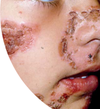Skin and Soft Tissue Infection Flashcards
(14 cards)
What is impetigo and how does it present?
- Golden encrusted skin lesions with inflammation localised to the dermis
- Signs/symptoms include vesicles/bullae, crusting and erythema
- Can be classified as bullous (always S. aureus) and non-bullous
- Most common in children and is contagious
- Caused by S. aureus and S. pyrogenes
- Usually self-limiting but can treat with topical fusidic acid or systemic antibiotics if required

What is a soft tissue abscess and how does it present?
- Infection within the dermis or fat layers with development of walled off infection and pooled pus
- Limited antibiotic penetration
- Best treatment is always surgical drainage
- Antibiotics not usualyl required if fully drained and no surrounding cellulitis
What is cellulitis and how does it present?
- Infection involving dermis
- Most commonly begins on lowe limbs
- Often tracks throught he lymphatic system and may involve localised lymph nodes
- May be associated with systemic upset
- Usually caused by β-haemolytic streptococci (Gp A Strep most common) and S. aureus
How is cellulitis classified?
- Enron Classification
- I) Patient not systemically unwell and no significant co-morbidities (A no antibiotics or <48hrs, B failed to respond to antibiotics >48hrs)
- II) Patient systemically unwell or has significant co-morbidities which may complicate or delay resolution of infection
- III) Patient has significant systemic upset or unstable co-morbidities that will interfere with response to treatment or limb threatening vascular compromise
- IV) Presence of sepsis or severe, life threatening complications
Management of cellulitis
- FBC (raised WCC) and cultures to diagnose
- Stage I/IA) 1st flucloxaxillin PO and 2nd doxycycline PO
- Stage IB/II) 1st flucloxaxillin IV and 2nd vancomycin IV
- Stage III/IV) Require hospital admission for IV therapy and consideration or surgical intervention
What are the clinical features of Streptococcal toxic shock?
- Caused by toxin producing Group A Streptococcus
- Primary infection typocalls within the throad or skin/soft tissue
- Patient’s with present with localised infection, fever and shock
- Often diffuse, faint rash over body/limbs
How is Streptococcal toxic shock treated?
- Surgery (drain abscesses)
- Antibiotics (penicillin may be ineffective, add clindamycin to reduce toxin production)
- Consider human immunoglobulin
What are the clinical features of necrotising fasciitis?
- Life threatening soft tissue infection
- Rapidly progressive with extensive tissue damage requiring extensive surgical debridement
- Pain out of proportion to clinical signs
- Presence of visible necrotic tissue
- Severe systemic upset
- Imaging may demonstrate fascial oedema and gas in soft tissues
- Type 1 - Polymicrobial (existing wounds)
- Type 2 - Group A Streptococcus (previously healthy)
What antibiotic therapy is used for necrotising fasciitis? (Fasciitis Can Get Mega Bad)
- Flucloxacillin
- Clindamycin
- Gentamicin
- Metronidazole
- Benzylpenicillin
NB - Also requires urgent surgical debridement (do not delay contacting surgeon if necrotising fasciitis suspected) and haemodynamic support
What are the clinical features of HSV and how is it treated?
- Primary infection asymptomatic in 60%
- Type 1 - stomatitis ‘cold sore’
- Type 2 - genital herpes
- Vesicular, may be painful
- Other symptoms include dysuria (in women), lymphadenopathy, genital ulcers, oral ulcers and tingling sensations.
- Recurrent (virus latent in sensory nerve ganglia)
- Blood or vesicle fluid for PCR to diagnose
- Treat with acyclovir
What are the clinical features of VZV and how is it treated?
- Chickenpox is self-limiting, highly infectious, diagnosed by PCR and can cause congenital abnormalities in pregnancy and pneumonitis in adults
- Shingles is reactivation of dormant VZV (dorsal root ganglia) with a dermatomal distribution and is treated with acyclovir in high risk patients (immunocompromised, disseminated)
- Supportive care
- Treat at risk adults (pregnant, immunocompromised, pneumonitis) with Aciclovir PO/IV
What organisms are common in bite injuries and how are they treated?
- Staphylococci, streptococci and anaerobic organisms common
- First line co-amoxiclav
- Second line doxycycline and metronidazole
- Surgical debridement may be required
Cause of cellulitis
- β-haemolytic streptococci (Gp A Strep most common) and S. aureus
Features of cellulitis
- Signs/symptoms include skin discomfort, macular erythema with indistinct borders of the skin, disruption of cutaneous barrier, raised erythema with clearly demarcated margins and Hx of diabetes.
- Risk factors include Hx of cellulitis, ulcers/wounds, dermatosis, tinea pedis interdigitalis, lymphoedema and venous.


